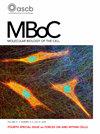生长因子受体系统在凝集素包被位点的空间和信号重叠。
IF 3.1
3区 生物学
Q3 CELL BIOLOGY
引用次数: 0
摘要
细胞通讯在质膜上通过受体蛋白、粘附蛋白、信号蛋白和内细胞蛋白的相互作用进行调节。然而,这些复合体的组成和控制对外部线索的反应仍不清楚。我们利用高分辨率和高通量荧光成像技术绘制了人类鳞状细胞 HSC3 中生长因子受体和相关蛋白在单个凝集素包被结构上的定位图。我们发现对照细胞和受到生长因子刺激的细胞中的蛋白质特征截然不同。质膜上的凝集素位点预载了某些受体,而不是其他受体。表皮生长因子刺激可诱导表皮生长因子、成纤维细胞生长因子和低密度脂蛋白受体(表皮生长因子受体、成纤维细胞生长因子受体1和低密度脂蛋白受体)的捕获和浓缩。包括泛素连接酶 Cbl、支架 Grb2 和机械酵素 dynamin2 在内的调节蛋白也会被招募。用药物干扰表皮生长因子受体或表皮生长因子受体的活性会阻止表皮生长因子受体和表皮生长因子受体1的招募。表皮生长因子能激活表皮生长因子1的磷酸化。我们的数据揭示了在单一生长因子(表皮生长因子或表皮生长因子)的刺激下,受体和调节因子在凝集素包被位点的新的共聚和激活。这种行为整合了生长因子信号,使人体细胞质膜对细胞外线索和药物做出复杂反应成为可能。本文章由计算机程序翻译,如有差异,请以英文原文为准。
Spatial and signaling overlap of growth factor receptor systems at clathrin-coated sites.
Cellular communication is regulated at the plasma membrane by the interactions of receptor, adhesion, signaling, and endocytic proteins. Yet, the composition and control of these complexes in response to external cues remain unclear. We use high-resolution and high-throughput fluorescence imaging to map the localization of growth factor receptors and related proteins at single clathrin-coated structures in human squamous HSC3 cells. We find distinct protein signatures between control cells and cells stimulated with growth factors. Clathrin sites at the plasma membrane are preloaded with some receptors but not others. Stimulation with epidermal growth factor induces capture and concentration of epidermal growth factor-, fibroblast growth factor-, and low-density lipoprotein-receptors (EGFR, FGFR1, and LDLR). Regulatory proteins including ubiquitin ligase Cbl, the scaffold Grb2, and the mechanoenzyme dynamin2 are also recruited. Disrupting FGFR or EGFR activity with drugs prevents the recruitment of both EGFR and FGFR1. EGF was able to activate FGFR1 phosphorylation. Our data reveals novel co-clustering and activation of receptors and regulatory factors at clathrin-coated sites in response to stimulation by a single growth factor, EGF or FGF. This behavior integrates growth factor signaling and allows for complex responses to extracellular cues and drugs at the plasma membrane of human cells.
求助全文
通过发布文献求助,成功后即可免费获取论文全文。
去求助
来源期刊

Molecular Biology of the Cell
生物-细胞生物学
CiteScore
6.00
自引率
6.10%
发文量
402
审稿时长
2 months
期刊介绍:
MBoC publishes research articles that present conceptual advances of broad interest and significance within all areas of cell, molecular, and developmental biology. We welcome manuscripts that describe advances with applications across topics including but not limited to: cell growth and division; nuclear and cytoskeletal processes; membrane trafficking and autophagy; organelle biology; quantitative cell biology; physical cell biology and mechanobiology; cell signaling; stem cell biology and development; cancer biology; cellular immunology and microbial pathogenesis; cellular neurobiology; prokaryotic cell biology; and cell biology of disease.
 求助内容:
求助内容: 应助结果提醒方式:
应助结果提醒方式:


